
Gibson’s electric and acoustic six strings are so fabled, it’s easy to forget the company’s basses. But there are some absolute classics at the heart of rock, blues and soul history and you can get improved models today.
1. It all started with the Gibson Bass Banjo in 1930 – before that it was the Cello Banjo. This advert alone suggests the EADG-tuned Bass Banjo was not a very practical instrument. Unless this rockin’ young lady is 2-foot tall?
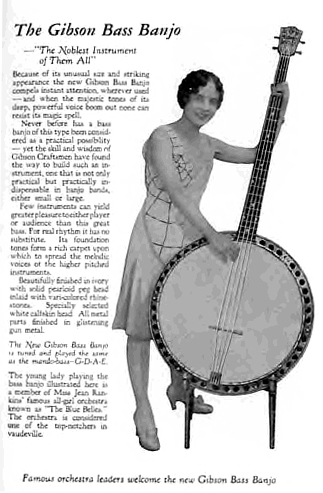
2. Say “violin bass’ to most players, and they’ll think of Paul McCartney’s famed Hofner 500/1. But Hofner’s violin-shaped basses debuted in 1956 – three years after Gibson’s similar-shaped Electric Bass (EB). Given that McCartney liked the Hofner for its symmetrical shape – aesthetically better for a left-hander playing a right-hand model – you could argue that had “Beatle Paul” been buying in the U.S and not Germany, he’d have bought a Gibson!
3. Gibson’s EB had fake f-holes painted onto its small body and had an extendible end-pin so you could play it horizontally like a standard electric bass or stand it upright like a double bass – good for that early ’50s rockabilly vibe. But the initial run was small: only 105 Gibson EBs were made in 1953.
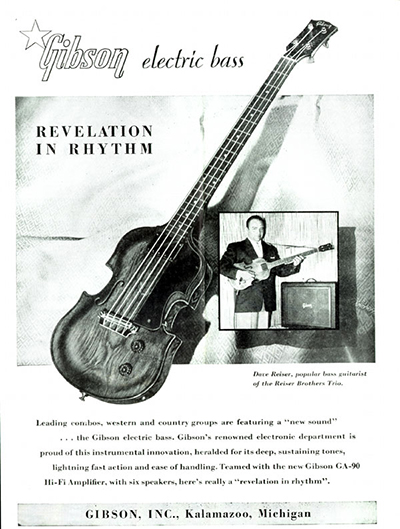
4. After slow sales, the EB (or EB-1 as it was later known) was replaced in the late ‘50s by a Les Paul Junior-shaped solidbody (slightly confusingly, called the EB-0 even though it superseded the “EB-1”) and the 335-shaped semi-solid EB-2. In 1961, the EB-0 changed its shape again, to that of the newly-launched twin-cutaway Les Paul SG.
5. Those early 335-shaped EB-2s are rare, made only from 1959 to 1961. It was reintroduced in 1964. You’re more likely to find originals of its budget cousin, the Epiphone Rivoli (also ’59-’61, before later being reintroduced.)
6. The SG-alike EB-0s and EB-3s hit it big from the mid-1960s. It was produced as the EB-0F (’62-‘65) with built-in fuzztone, but most notably as the dual-humbucker EB-3 (from 1961). Jack Bruce (Cream), Bill Wyman (The Rolling Stones), Andy Fraser (Free), Trevor Bolder (David Bowie) and Chris White (The Zombies) all played an EB-3, as did Phil Lesh (The Grateful Dead).
Here’s Cream’s “Sunshine Of Your Love” with Jack Bruce on one of his EB-3s and Eric Clapton on his custom-painted Gibson “Fool” SG.
7. The original run of EB-3s was one of Gibson’s most successful ever basses: almost 15,000 basses were shipped (before the model was initially discontinued in 1979) with 1969 to 1973 being peak sales years.
8. The large Gibson EB humbucking pickup became known in the bass community as the “mudbucker.” It was essentially the same design as on an EB-0, but the extra switching options of the EB-3’s Varitone control gave a super-bassy “muddy” sound. To some, the “mudbucker” name is an insult, to others it’s a reason to buy. It thuds!
9. 1963 saw the launch of the full-scale Gibson Thunderbird, a high-end instrument that complemented Gibson’s 6-string Firebird. Like the Firebird, its curves were outlined by U.S. auto designer Raymond H. Dietrich who had conceived classic cars for Chrysler and Lincoln and the Checker A2 cab (patent pictured). Dietrich liked curves!
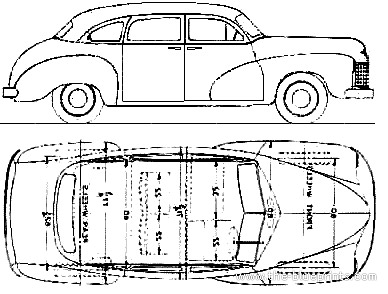
10. The Thunderbird (II and IV models) was Gibson’s first long-scale bass (34.5 inches). It was also the first Gibson bass with neck-through construction, where one central piece of mahogany spanned the entire length of the bass, and mahogany “wings” were glued to the sides to make the body.
11. From 1963 to 1969, Thunderbirds (and the 6-string Firebirds) were remodelled as “non-reverse” shapes. These had mahogany set-necks and one-piece bodies.
 Gibson Grabber, Gibson L-9S Ripper, and Gibson G-3 in natural finish. Photo credit: Mike Gutierrez.
Gibson Grabber, Gibson L-9S Ripper, and Gibson G-3 in natural finish. Photo credit: Mike Gutierrez.
12. In the 1970s, it was all change as the SG-style EBs ended production in 1973. The Gibson Grabber was so-named because it had a sliding pickup, which you could “grab” and move along the strings for different tones. Rad! Note that some of Dan Armstrong’s guitars of the same era featured a sliding pickup, too. Who was first?
13. The Gibson Grabber also had a bolt-on neck, a first for Gibson basses, and were made of maple or alder which contributed to a brighter, more treble-y tone from the get-go. Oh, and if you see a rare Gibson G-3, it’s essentially a Grabber with modified pickups and electronics.
14. In the 1970s, there was also the Gibson Ripper. It had two humbuckers again but with Bill Lawrence’s ‘Q-system’ to provide extra tones. Gibson even issued a 45-rpm vinyl promo record to demonstrate the tones at your fingertips. Chicago’s Peter Cetera was a high-profile user of the Gibson Ripper as was Nirvana’s Krist Novoselic. Kiss’s Gene Simmons was a fan of both The Ripper and The Grabber, the latter being a regular gigging bass.
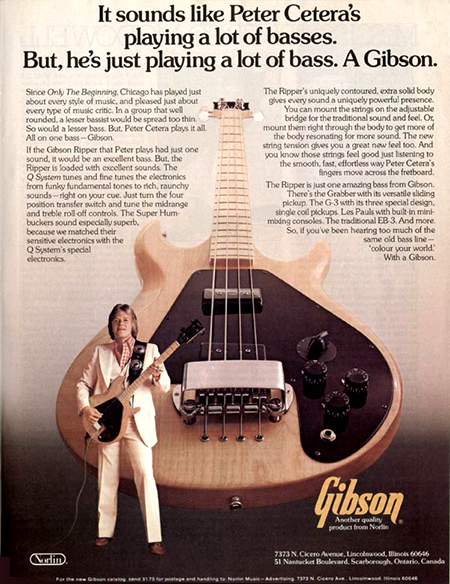
15. We shouldn’t forget some lesser-famed Gibson basses of the era. The original Gibson Les Paul Bass (from 1969) was unique. A companion model to the Les Paul Personal and Les Paul Professional 6-strings, it was fitted with low impedance electronics and pickups. As such, it required a low impedance amp (such as Gibson’s LP1 preamp and LP2 cabinet, simultaneously launched). Although an infamously heavy bass, Suzi Quatro used one – “this weighs more than I do” she joked.
It was eventually replaced by the similar Les Paul Triumph Bass, which added a Hi-Lo impedance selector switch to allow for easier use with a conventional amp. Well-known Les Paul Triumph players include Gary Valentine from Blondie, Alex James from Blur, and Paul “Guigsy” McGuigan from Oasis.
16. Replacing the Ripper in 1977 were Gibson’s RD basses – the RD Artist model had active electronics developed in collaboration with synth pioneer Robert Moog. Original RDs were short-lived – they ceased production in 1981 – but are still in demand, used. The RD was another new body design but with clear echoes of the Gibson Firebird six-string and Thunderbird bass.
17. Krist Novoselic was also a fan of the RD and Gibson produced a limited edition Krist Novoselic RD Signature in 2011.
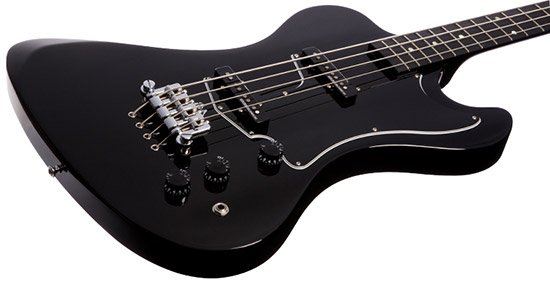
18. Renowned bassist Mike Watt (the Minutemen, solo, The Stooges) is quite the Gibson bass fan. Watt says, “There’s something about mahogany, there’s a warm roundness, maybe not as much definition as a maple neck… there’s a character I get from my Thunderbird and EB-3s.
19. The Gibson Victory (1981-’86) was quite unlike any other Gibson bass, with a stark asymmetrical shape and deep cutaway. Geek fact? The Victory was Gibson’s first two-octave long-scale bass. The Rebel Victory model came with a confederate flag finish.
20. When does a Gibson bass look like anything but a Gibson? When it’s co-designed by Ned Steinberger. The Gibson 20/20 hollers “1980s!” so loud you can almost smell the hairspray. Anyone out there own one of these rare things?
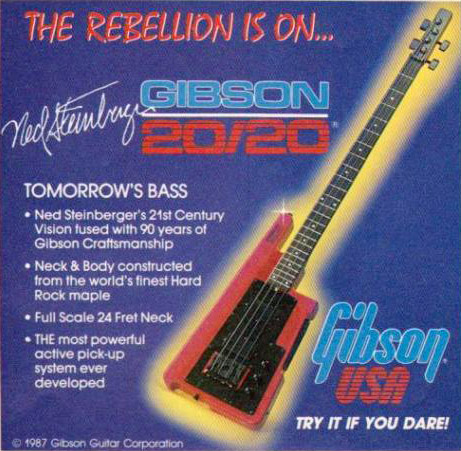
21. With their long history and numerous models, Gibson bass names have been confusing for some players over the years. Gibson’s current range includes updates and improvements on old favorites and new design that add a modern twist….
The Gibson Thunderbird is top of the line, with the latest pickups and hardware married to the classic outline. There are three colors, of which Vintage Sunburst is the one for nostalgics.

22. The Gibson EB Bass is back in name, but with a new body design and some great options. It comes in 4-string and 5-string versions and tuned coil-tapped humbuckers. Unlike the ’60s EB-3s, the 2014’s EB’s swamp ash body now promises a “strong low end without a hint of mud.” Mudbuckers, be gone!

Here’s Robert Plant’s bassist Billy Fuller demonstrating the myriad tones the new EB can deliver.
23. And, yes, SG-style basses are now called… SG Basses. Thanks, finally, Mr Marketing! Four current options including the SG Standard Bass, but a stand-out has to be the 2014 SG Standard Bass Faded. With vintage-voiced pickups this is close to classic ’60s “SG” basses played by Cream’s Jack Bruce, but at an incredible price.

24. The Gibson Les Paul Standard Bass is still popular. Geeky fact? Recent year’s LP Basses were known as “oversized” as the body was actually 1/8-inch bigger all-round – though you’d need a tape measure to notice, frankly. But the 2014 is all in perfect Les Paul proportion. Sunburst, Ebony and Goldtop finishes keep things classic.

25. And, semi-acoustic Gibson basses are still coveted by many. The Midtown Standard echoes the EB-2 of the ’60s, while the Midtown Signature (below) echoes the Les Paul Signature Bass of the 1970s… but with two pickups. What goes around comes around!

And in the same-ish body style, Gibson sister-brand Epiphone produce a Jack Casady Signature Bass with a single pickup, just like his original 1970s Les Paul Signature. Keep up!
Geeky fact about Jefferson’s Airplane’s Jack Casady? He played on Jimi Hendrix’s “Voodoo Chile” alongside Jimi, Steve Winwood and Mitch Mitchell. The loose jam session began in New York at 2:30am and only ended circa 7:30 at dawn. At 15 minutes, “Voodoo Chile” is Jimi Hendrix’s longest studio recording.
From the past to the present and beyond… who says bass is boring?


